LIMA —
On September 22, Carlos Lalangui was digging a trench to make way for a natural
gas pipeline on the outskirts of Lima,
Peru when he spotted fragments of a
human skull in the loosened soil.
اضافة اعلان
“It was the
first time I’d seen something like that,” said Lalangui, a worker with the
natural gas company Cálidda. “But I knew it was a possibility.”
He stopped
digging and notified his supervisor, who called in
archaeologists. In a little
more than a week, they had uncovered the remains of 21 people, eight of them
children, who lived 600 to 800 years ago, said Cecilia Camargo, an
archaeologist with the company.
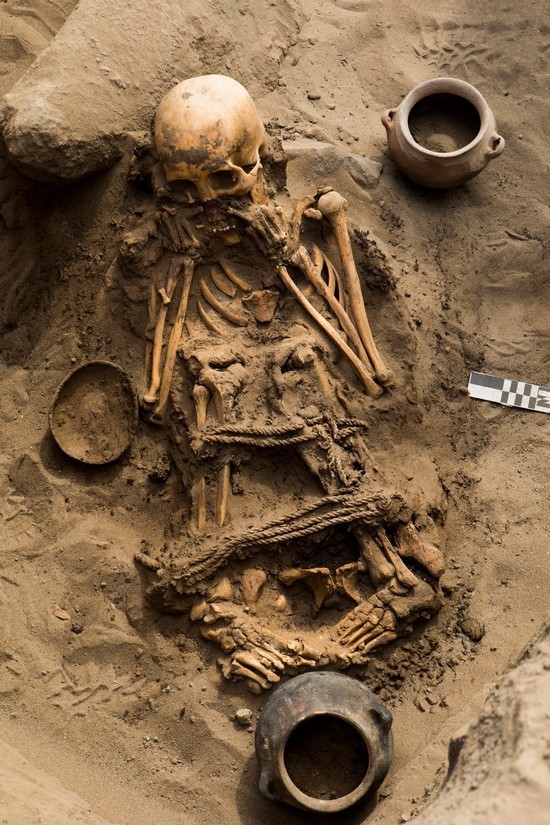 Carlos Lalangui (right) digs around the remains of a funerary bundle in an ancient tomb discovered beneath a street in a residential district north of Lima, Peru on September 30, 2022.
Carlos Lalangui (right) digs around the remains of a funerary bundle in an ancient tomb discovered beneath a street in a residential district north of Lima, Peru on September 30, 2022.
Most had been
buried in a classic pre-Columbian style: their bodies bound in a sitting fetal
position and bundled in layers of textiles, surrounded by ceramic vessels, plates,
pots, and figurines.
The graves,
discovered in a residential neighborhood in Carabayllo, a district in northern
Lima Province, were a reminder of Peru’s seemingly ubiquitous pre-Columbian
cultural legacy, which continues to surface long after the Spanish conquest
decimated the
Indigenous population.
In Lima, huacas
— pyramidlike mounds of adobe brick that were once used as sacred and
administrative centers — are the most visible reminder of the city’s ancient
inhabitants. Dozens of ruins of huacas remain nestled among skyscrapers,
middle-class neighborhoods, and shantytowns.
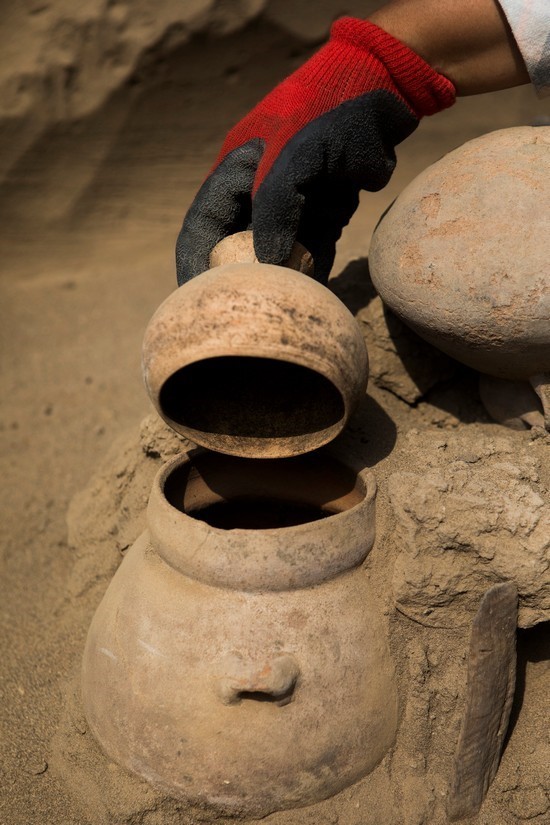 An archaeologist cleans ceramics found in an ancient tomb discovered beneath a street in a residential district north of Lima, Peru on September 30, 2022.
An archaeologist cleans ceramics found in an ancient tomb discovered beneath a street in a residential district north of Lima, Peru on September 30, 2022.
In recent years,
ancient tombs and ceramics have been found during the expansion of the city’s
airport and during the construction of a courthouse and a hydroelectric dam in
towns nearby. Earlier this year, a resident of Lima called culture authorities
to report funeral bundles he found while doing construction work on his house,
said Yuri Castro, the culture ministry’s director of archaeological heritage.
Peru’s culture
ministry has registered some 26,000 archaeological sites across the country.
But budget constraints mean that only a fraction can be properly protected,
Castro said. More than 1,100 sites are in Lima, a sprawling metropolis of 10
million people that has been occupied for more than 3,000 years.
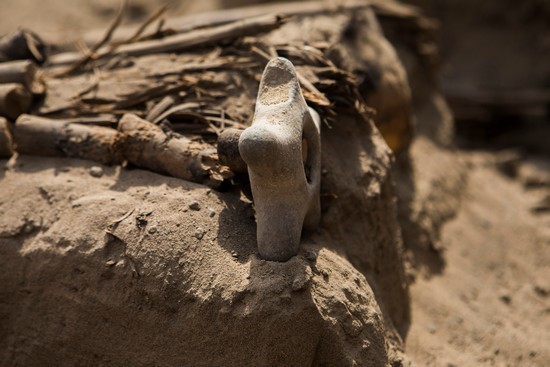 A stone mace found in a funerary bundle in an ancient tomb discovered beneath a street in a residential district north of Lima, Peru on September 30, 2022.
A stone mace found in a funerary bundle in an ancient tomb discovered beneath a street in a residential district north of Lima, Peru on September 30, 2022.
“Those are only
the sites that remain,” Castro said. “With the city’s expansion they’ve
gradually disappeared.”
Cálidda has made
more than 1,500 archaeological findings in the nine years it has been laying
natural gas pipelines across metropolitan Lima, said Camargo, and it employs a
team of 30 archaeologists. “In Lima, 3,000 years of history are literally just
beneath our feet,” she said. “We’ve made findings in nearly every district.”
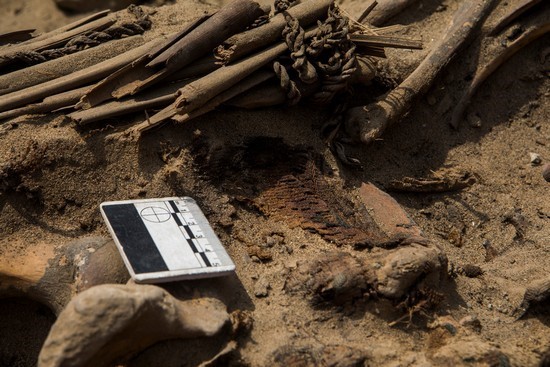 Textile fragments found in an ancient tomb discovered beneath a street in a residential district north of Lima, Peru on September 30, 2022.
Textile fragments found in an ancient tomb discovered beneath a street in a residential district north of Lima, Peru on September 30, 2022.
Today the
coastal region is home to most of Peru’s population, and countless sites have
already been lost to looting and development.
“It’s a victory
every time archaeologists can recover something responsibly and put it into the
record,” said Daniel Sandweiss, the president of the Society for American
Archaeology, who studies how pre-Columbian coastal societies in Peru adapted to
climate change caused by El Nino. “Peru has the most fascinating pre-European
records of any place in the Americas.”
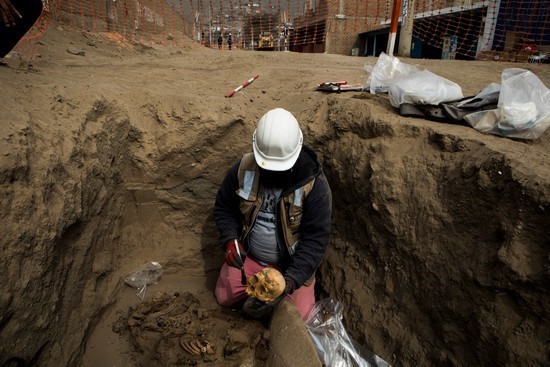 Roberto Quispe, one of 30 archaeologists with the natural gas company Cálidda, cleans human remains from an ancient tomb discovered beneath a street in a residential district north of Lima, Peru on September 30, 2022.
Roberto Quispe, one of 30 archaeologists with the natural gas company Cálidda, cleans human remains from an ancient tomb discovered beneath a street in a residential district north of Lima, Peru on September 30, 2022.
John Villareal,
another laborer at the site, said that when he was a boy, he dug up graves at a
pre-Columbian burial ground in his village in northern Peru near the city of
Chiclayo, working in 10-man teams with other laborers.
“Buyers would
come from Chiclayo, and we’d sell the pieces for a pittance because we didn’t
know what they were worth,” Villareal said. He recalled finding and trading
masks, shell necklaces, gold pectorals, and ceramic sculptures with erotic
themes.
The newly
uncovered graves were most likely part of a cemetery used for hundreds of years
by different groups that farmed along the Chillón River, said Roberto Quispe,
an archaeologist with Cálidda. Archaeologists first became aware of it after
seeing aerial photos, taken in the 1940s, that showed the telltale signs of
tomb raiding.
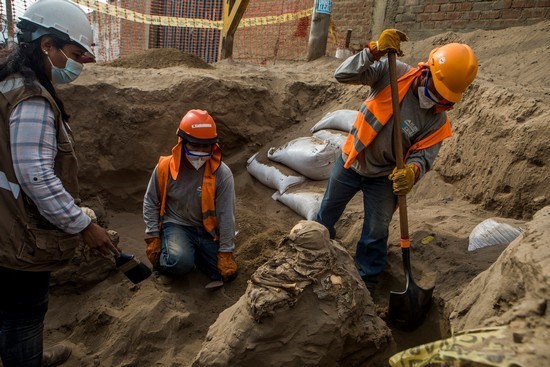 Carlos Lalangui (right) digs around the remains of a funerary bundle in an ancient tomb discovered beneath a street in a residential district north of Lima, Peru on September 30, 2022.
Carlos Lalangui (right) digs around the remains of a funerary bundle in an ancient tomb discovered beneath a street in a residential district north of Lima, Peru on September 30, 2022.
“You see some
plots of farmland and next to them an empty lot that’s completely full of
holes,” Quispe said. “The cemetery had been completely looted and people
started to settle on top of it.”
The objects
found in the graves correspond to the Chancay culture, which occupied an area
north of Lima from 1200 to 1450 AD, and to an earlier cultural development
known as Huaura. The unearthed items include a ceramic flute, a figurine
perhaps representing a goddess, and an early version of a cuchimilco, which is
a ceramic figurine with an expression of awe or surprise that was placed in
Chancay tombs to accompany the dead.
Little is known
about Chancay occupations this far south, Camargo said. Detailed studies of
other skeletal remains in the area suggest that some populations may have been
suffering from anemia and health problems; large numbers of children have been
found at some burial sites.
“What was going
on at that time?” Camargo asked. “Maybe those people were migrating.”
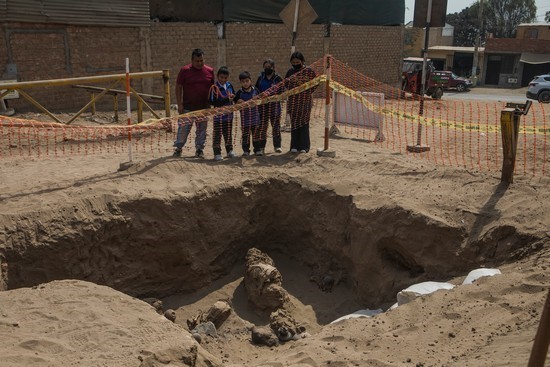 Residents look at the site of an ancient tomb discovered beneath a street in a residential district north of Lima, Peru on September 30, 2022.
Residents look at the site of an ancient tomb discovered beneath a street in a residential district north of Lima, Peru on September 30, 2022.
Most of the
findings made by Cálidda during pipe laying are of pre-Columbian ceramics. But
the company’s archaeologists have also found dozens of pre-Columbian graves,
including 40 in a half-block in the heart of the city, and the remains of three
Chinese indentured laborers who came to Peru in the 19th century and were
buried near former agricultural plantations.
Also in the
city’s center, the archaeologists have discovered abundant examples of a
2,000-year-old ceramic style known only as “white on red”.
“It’s been
studied so little that researchers still don’t refer to it as a culture,”
Camargo said.
The gas company
has opened community museums and exhibits in the districts where findings have
been made so that residents can view them.
“You can see how they
connect it with their history,” Camargo said. “That connection, and that
interest, is immediate.”
Read more Odd and Bizarre
Jordan News



